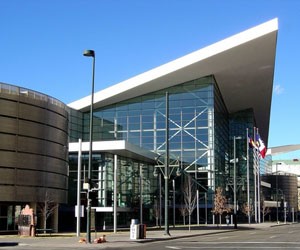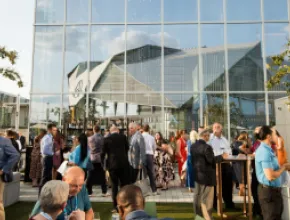The steady tide of convention center expansions is continuing in full force, with cities across the nation looking to attract more events.
With competition mounting for convention business, many of these enhanced facilities are being designed to fulfill the requirements for service and technology that planners now expect.
At the beginning of 2011, a massive expansion was unveiled at the Indianapolis Convention Center, doubling its size.
“This expansion has taken us from being the 32nd largest convention city in the country to the 16th largest,” says Michelle Travis, vice president of sales for the Indianapolis Convention & Visitors Association. “The reception has been fantastic. So far, we’ve booked 69 conventions, totaling nearly $1.3 billion in economic impact for the city, thanks to the expansion.”
Excitement is also at its peak in Philadelphia, where the city debuted a $786 million expansion to its Pennsylvania Convention Center in early March.
“We are overly excited; if there was a word that registered more than excited, that would be what we are right now,” says Stephanie Boyd, vice president of sales, marketing and convention services for the Pennsylvania Convention Center. “We are going from 1 million square feet to 2.2 million.”
Across the continent in San Diego, plans are under way for a major expansion to the city’s convention center.
“We have secured the land for the expansion and hope to have a shovel in the ground by 2012,” says Steven Johnson, vice president of public affairs for the San Diego Convention Center Corp. “Our goal is to have the building open for Comic-Con in 2015.”
According to Johnson, the expansion will add 225,000 square feet of exhibit space, 100,000 square feet of meeting rooms and 80,000 square feet of ballroom space to the existing center.
And in Miami, plans are under way for a possible expansion to the Miami Beach Convention Center, albeit in the infancy stages, according to Jeffrey Rugg, marketing manager for the center.
Why are so many cities expanding convention centers? The answer is simple: They want to attract bigger business and more of it.
“Right now we are turning away a substantial amount of business because we don’t have the space available in our existing facility,” says Andy Mikschl, vice president of sales for the San Diego Convention Center Corp. “With an expansion, we could not only book larger shows, but smaller shows concurrently with larger ones. Plus, many of our current events are on par to outgrow us in five to seven years. We want to be ready to accommodate them as they grow.”
Pennsylvania’s Boyd echoes Mikschl’s sentiment.
“We want to remain competitive,” she says. “This expansion will allow us to go back to the table and talk to people we weren’t able to accommodate before.”
Too Much Space?
This recent onslaught of convention center expansions has some meeting planners wondering if there is really the market to support them.
“How are they going to sell all of that space?” asks MaryAnne Bobrow of Bobrow & Associates, an association and meetings management company based in Cirtus Heights, Calif. “Lets face it; a lot of convention space is going to go without tenants. I still think people are being very cautious.”
Diane Davis, vice president, meetings and marketing consulting for TulNet, a meetings management and marketing company in Tulsa, Okla., is also a little dubious.
“It will be interesting to see if we will get to a point of oversaturation, just like the times when the market has too much hotel product,” she says. “Will that happen with convention centers, too?”
Changing Needs
Beyond increasing size, convention center expansions are designed to serve the changing needs of convention groups.
“Our clients are expecting and demanding the same or better service levels in convention centers as in hotel properties,” Mikschl says. “We have door greeters who welcome our convention center guests, just like at a luxury hotel.”
According to Carole Garner, project manager for MeetGreen, a meeting management company in Portland, Ore., service is paramount these days, even at convention centers.
“I look very hard at service levels; it is definitely part of my selection process,” she says.
Along with service, connectivity at convention centers is another major concern for planners these days.
“Wireless has become a big thing with meetings,” says Indianapolis’ Travis. “Attendees used to be disconnected on the convention floor and that was fine, but nowadays, they are still working. They want wireless throughout and that is something we have implemented.”
Bobrow agrees that wireless connectivity is absolutely essential.
“People are tied to their electronic devices and if they can’t access them in a facility without a great deal of effort or trouble, they are not going to stay inside,” she says. “I remember being at a meeting a few years ago where my cell phone battery kept dying because it was being used up trying to find a signal. It was incredibly frustrating. Now, I want to make sure that every convention center I go to has the latest and greatest technology available.”
According to Davis, planners now expect convention centers to be seamlessly connected to hotels.
“I really want a convention center to have a finished, hotel lobby look,” she says. “If the center has a totally different feel from the hotel, that’s not good. Especially if the convention center has an industrial, governmental feel to it.”
Green Considerations
When it comes to selecting a convention center for an event, what kind of weight is given to sustainability and green practices? It depends on whom you ask.
“There are still clients out there that want the best value and being green is not the primary concern,” Bobrow says. “But when I’m looking, I am going to take note of how the center recycles their food and plastics, at the very least. I want to know the steps they are taking.”
Davis says a convention center’s sustainability plan is of utmost importance in her site selection process.
“Many convention centers will bill themselves as green facilities, but they might just be recycling the trash,” she says. “I am okay with it as long as they are in the process of going green. I want to know that they are taking steps to move forward.”
The Indianapolis Convention Center is way ahead of the game, and things like food rescue programs, recycling, tote bag donation, water stations and lighting conservation are part of every day at the facility.
“Being green is incredibly important to us,” Travis says.
Food for Thought
While food served at convention centers used to conjure up images of rubber chicken, frozen vegetables and stale rolls, many facilities have turned this around and are serving meals on par with hotels and restaurants.
“The marginal food of the past just doesn’t cut it anymore,” San Diego’s Mikschl says. “We have a world-class chef that creates amazing menus for our clients—something they have come to expect from a convention center.”
Davis says quality convention center food is absolutely essential for her groups.
“Convention center food is a huge deal,” she says. “We all know that convention centers in the past have had a reputation for having not the greatest food. Now, groups want hotel- and restaurant-quality food.”
Food quality is something Davis includes in the site selection process.
“I want to be able to have a tasting in advance,” she says. “I want to work with a very involved chef that has a good understanding of what groups need.”
Future Facilities
By most counts, convention centers of the future will look quite different from those designed in years past.
For example, the San Diego Convention Center is planning a five-acre rooftop park as part of its expansion project. According to Johnson, the park will serve as an attraction for not only meeting attendees, but San Diegans as well.
“It will create the largest concentration of open space in downtown San Diego,” he says. “We will have civic events up there and the park will have incredible views of the bay.”
Also big on the list of changes will be connectivity to nearby hotels and attractions, like at the Indianapolis Convention Center.
“We are an incredibly walkable city with a highly connected convention center to many hotels,” Travis says. “In addition, there are so many things to do downtown that planners never need to worry about shuttling.”
Hotel accessibility for meeting attendees is a large issue for Davis.
“I want them within walking distance of the convention center,” she says. “And preferably connected to the hotels via a climate-controlled walkway, so my attendees are not out in the elements.”
In addition to positioning themselves for bigger conferences, Davis sees convention center expansions altering the status of the tiered destination system.
“Third-tier cities are bumping themselves to be second-tier cities,” she says. “And second-tier cities are trying to posture themselves against first-tier cities.”
Katie Morell is a Chicago-based freelance writer and former Meetings Focus editor: www.katiemorell.com.






